Sushi culture is mysterious and the etiquette complex, but fortunately we have this entertaining video by Japan Culture Lab to explain it all. A must-see for anyone who has ever wondered why Japanese feet smell like vinegar.
Archives: February 2007
Tiny robot reduces need for surgery
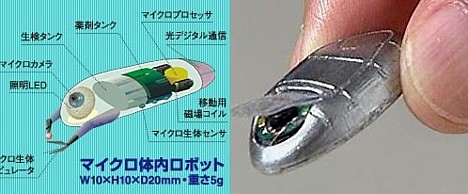
On February 26, researchers from Ritsumeikan University and the Shiga University of Medical Science completed work on a miniature robot prototype that, once inserted into the body through an incision, can be freely controlled to perform medical treatment and capture images of affected areas. The plastic-encased minibot, which measures 2 cm (0.8 inch) in length and 1 cm (0.4 inch) in diameter, can be maneuvered through the body by controlling an external magnetic field applied near the patient.
While other types of miniature swallowable robots have been developed in the past, their role has mostly been limited to capturing images inside the body. According to Ritsumeikan University professor Masaaki Makikawa, this new prototype robot has the ability to perform treatment inside the body, eliminating the need for surgery in some cases.
The researchers developed five different kinds of prototypes with features such as image capture functions, medicine delivery systems, and tiny forceps for taking tissue samples. MRI images of the patient taken in advance serve as a map for navigating the minibot, which is said to have performed swimmingly in tests on animals. Sensor and image data is relayed back to a computer via an attached 2-mm diameter cable, which looks like it can also serve as a safety line in case the minibot gets lost or stranded.
[Source: Chugoku Shimbun]
Videos by Koichiro Tsujikawa (+ Cornelius)
Koichiro Tsujikawa is a self-taught video artist who began as a graphic designer and visual producer for live concerts. Here are a few of his surreal works...
- Untitled (2004): This short film about an alien athlete was commissioned by Panasonic for the 2004 Olympics.
- Eyes (2004): This video was commissioned by Getty Images as part of The Big Idea, where filmmakers created short pieces from Getty Images content (check the link for other cool shorts). Soundtrack by Cornelius.
- Fit Song - Cornelius (2006): Household objects go crazy when stop-motion video meets computer animation. From the album "Sensuous."
- Beep It - Cornelius (2006): Also from the "Sensuous" album. More stop-motion madness with household objects.
Check out Koichiro Tsujikawa's homepage for more background info and links to other videos for Cornelius, as well as for UA, Rip Slyme, and more.
Ubiko robot knows where the smokers hang
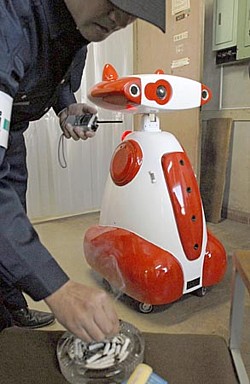 Robot manufacturer tmsuk, Kyushu University and the Kanazawa Institute of Technology have teamed up to develop a robot that can sniff out the smells that accompany fire. A public demonstration of the robot's new abilities was held at Kyushu University on February 21.
Robot manufacturer tmsuk, Kyushu University and the Kanazawa Institute of Technology have teamed up to develop a robot that can sniff out the smells that accompany fire. A public demonstration of the robot's new abilities was held at Kyushu University on February 21.
The researchers outfitted a 60-kilogram (132-pound), 112-centimeter (44-inch) tall Ubiko -- a tmsuk robot originally designed to serve as a temporary receptionist -- with a first-of-a-kind set of olfactory sensors specifically tuned to detect the odors of smoke and ash.
In the test, Ubiko, which moves on wheels and has a slightly humanoid appearance (albeit with a pair of triangular feline ears atop its head), was tasked with patrolling four rooms, each with a different smell. One room smelled of perfume, one smelled of garlic, one smelled of cigarettes, and one was odorless. When the robot smelled the room with ashtrays, it identified it as likely to catch fire and sent a wireless message to security.
Kiyoshi Toko, electronic engineering professor at Kyushu University, says, "We want to increase the accuracy of the sensors and create a fire-prevention robot that can detect subtle smells that humans cannot perceive."
For now, the robot has no fire-fighting skills except the ability to alert the authorities when it detects a funny smell. This is probably a good thing in an office environment, for example, where Ubiko might wreak havoc by spraying fire retardant on heavy smokers or on innocent employees who happen to visit smoky restaurants during their lunch breaks.
[Source: Nikkei Net]
Time-lapse video of deep-sea feeding frenzy
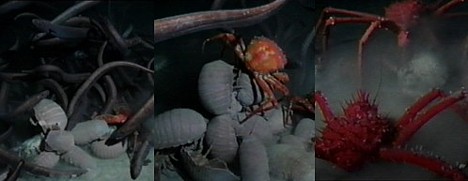
This video clip from NHK's "Planet Earth" shows the scene at dinner time on the deep ocean floor. The footage, which appears to have been shot by the Japanese submarine Shinkai 6500 in Okinawan waters at a depth of over 1500 meters (5,000 feet), shows sea-floor scavengers fighting for their piece of a fish carcass that has drifted down to the bottom. Crabs, eels and giant isopods (Bathynomus giganteus), which look like 30 centimeter (1 foot) long wood lice, join in the feeding frenzy that lasts several hours. Here it is time-lapsed to about 20 seconds for maximum impact. Itadakimasu.
Hitachi develops RFID powder
RFID keeps getting smaller. On February 13, Hitachi unveiled a tiny, new "powder" type RFID chip measuring 0.05 x 0.05 mm -- the smallest yet -- which they aim to begin marketing in 2 to 3 years.
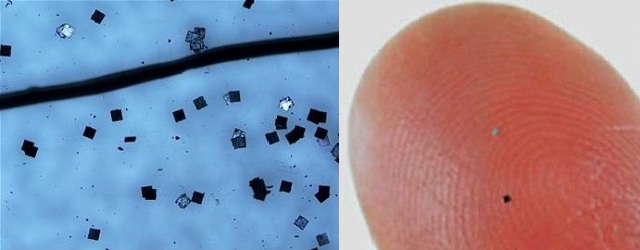
Hitachi's new RFID chips (left, next to a human hair) are 64x smaller than their mu-chips (right)
By relying on semiconductor miniaturization technology and using electron beams to write data on the chip substrates, Hitachi was able to create RFID chips 64 times smaller than their currently available 0.4 x 0.4 mm mu-chips. Like mu-chips, which have been used as an anti-counterfeit measure in admission tickets, the new chips have a 128-bit ROM for storing a unique 38-digit ID number.
The new chips are also 9 times smaller than the prototype chips Hitachi unveiled last year, which measure 0.15 x 0.15 mm.
At 5 microns thick, the RFID chips can more easily be embedded in sheets of paper, meaning they can be used in paper currency, gift certificates and identification. But since existing tags are already small enough to embed in paper, it leads one to wonder what new applications the developers have in mind.
[Source: Fuji Sankei]
Certification test for underwear fans and fetishists
 Japanese clothing manufacturer Gunze has announced the establishment of an underwear knowledge certification test called the Gunze Pantsu Kentei, which they will begin offering on March 1.
Japanese clothing manufacturer Gunze has announced the establishment of an underwear knowledge certification test called the Gunze Pantsu Kentei, which they will begin offering on March 1.
Open to anyone interested (who can read Japanese), the test consists of 100 multiple-choice questions designed to measure one's general and historical knowledge of underwear. The questions vary in difficulty and range from the obvious to the arcane.
Test takers are assigned a certification level (1 to 4) based on their results, and they are given a nationwide rank to see how they stack up against the competition. Top performers will be awarded special prizes, the company says.
The Gunze Pantsu Kentei website, which is still under construction, has posted a few sample questions, including:
- How do you say "underwear" in Thai?
- When is Underwear Day?
- What were the world's first commercially available underwear briefs called?
- How do you say "T-back" in English?
- Who gave Kitaro [from the manga/anime Ge Ge Ge no Kitaro] the "demon underpants" (oni no pantsu) he wears?
(Any aspiring Level 1 experts know the answers to these questions?)
Although the Gunze Pantsu Kentei may be a marketing gimmick to promote the company's undergarment sales, it could very well become the much-needed defacto standard by which underwear insiders measure their knowledge of things unmentionable.
[Link: Gunze Pantsu Kentei]
World’s most complex origami
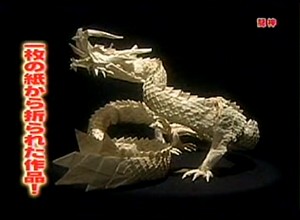 Check out this video showing three amazing creations by master origamist Satoshi Kamiya. Hard to believe, but each of the pieces shown in this video was folded from a single sheet of paper.
Check out this video showing three amazing creations by master origamist Satoshi Kamiya. Hard to believe, but each of the pieces shown in this video was folded from a single sheet of paper.
The red dragon, made from a 1.2 x 1.2 meter sheet, took only 6 hours to fold. The yellow hornet was commissioned by luxury retailer Hermes and was put on display in their New York store. The white dragon is fashioned from a 2 x 2 meter sheet of paper. "As far as I know, it is the most complex origami in the world," says Kamiya in the video.
Check out Kamiya's gallery for photos of his other paper creations.
[Via: Japan Probe]
Yuki-taro autonomous snowplow robot

The harsh winter in Niigata, Japan brings heavy snow, which can pose problems for residents -- particularly the elderly -- who are faced with the laborious task of clearing it from driveways and entrances. To the rescue comes Yuki-taro, an autonomous snowplow robot developed by a team of researchers from five Niigata-area organizations.
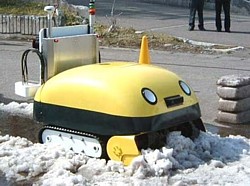 The friendly-looking Yuki-taro measures 160 x 95 x 75 cm (63 x 37 x 30 in.) and weighs 400 kg (880 lbs). Armed with GPS and a pair of video cameras embedded in its eyes, the self-guided robot seeks out snow and gobbles it up into its large mouth. Yuki-taro's insides consist of a system that compresses the snow into hard blocks measuring 60 x 30 x 15 cm (24 x 12 x 6 in.), which Yuki-taro expels from its rear end. The blocks can then be stacked and stored until summer, when they can be used as an alternative source of refrigeration or cooling.
The friendly-looking Yuki-taro measures 160 x 95 x 75 cm (63 x 37 x 30 in.) and weighs 400 kg (880 lbs). Armed with GPS and a pair of video cameras embedded in its eyes, the self-guided robot seeks out snow and gobbles it up into its large mouth. Yuki-taro's insides consist of a system that compresses the snow into hard blocks measuring 60 x 30 x 15 cm (24 x 12 x 6 in.), which Yuki-taro expels from its rear end. The blocks can then be stacked and stored until summer, when they can be used as an alternative source of refrigeration or cooling.
Yuki-taro is the result of nearly seven years of work by researchers from the Niigata Industrial Creation Organization (NICO), Research and Development, Inc. (RDI), Niigata Institute of Technology, Yamagata University and the Industrial Research Institute of Niigata Prefecture (IRI), who set out to design an environmentally-friendly robot that can operate by itself and support the elderly. In 2006, Yuki-taro received a Good Design Award in the small-to-medium sized enterprise category.
Researchers continue to work on reducing Yuki-taro's size, weight and cost, and they hope to make it commercially available in five years at a price of less than 1 million yen ($8,300). It is unclear whether or not the researchers intend to further enhance the robot's "cute" factor, but they might ought to consider attaching a pair of pointy ears. O-negai!
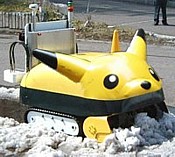
[Sources: Asahi]
